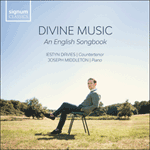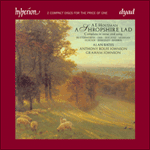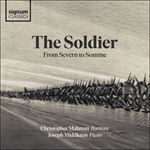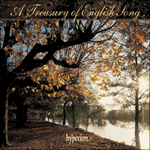
Welcome to Hyperion Records, an independent British classical label devoted to presenting high-quality recordings of music of all styles and from all periods from the twelfth century to the twenty-first.
Hyperion offers both CDs, and downloads in a number of formats. The site is also available in several languages.
Please use the dropdown buttons to set your preferred options, or use the checkbox to accept the defaults.

It was in Butterworth’s Housman settings that English folksong was wholly and effortlessly absorbed into English art song, and no more so than in the perfection of ‘Loveliest of trees’. Its opening is a brief, magical descending phrase for piano, which seems to encapsulate both the delicacy and transience of the blossom and, by extension, of life itself. This and other snatches of melody in the song, such as the exultant outburst at the end of the first stanza, form the basis of the later orchestral rhapsody.
‘When I was one-and-twenty’ is the only time when Butterworth uses a traditional folk tune in his Housman songs. The young man’s bitter realisation of the folly of spurning the ‘wise’ man’s advice is brilliantly emphasised by a mere one-bar extension of the tune at the conclusion of the song. In ‘Look not in my eyes’ Housman alludes to the myth of Narcissus. It is set to a flowing melody in 5/4 time and has a fine moment of word painting at the end of the first verse where, on the word ‘eyes’, the music literally halts with an arpeggiated chord of C major, epitomising the forbidden long deep gaze. It is contrasted by a devil-may-care rendering of ‘Think no more, lad’, a fine piece of musical irony with a superficially carefree manner that masks the darker undertones of the poem.
A characteristic of the songs is their economy of means, something which is amply demonstrated in ‘The lads in their hundreds’ with its lilting melody, piano ritornello between verses derived from it and spare harmony. Arguably Butterworth’s greatest Housman setting, ‘Is my team ploughing?’ is a conversation between the quick and the dead with melody and harmony that are heart-rending in effect. Irony, once again, is at the heart of the poem where the ghost poses a series of questions to his living friend about his former life and lover. The poignant falling sequence of bare chords uncannily suggests the cold of the grave; by comparison the chords underpinning his friend’s answers course with life. After the chilling last response, side-stepping the truth about the fate of the dead man’s girl, the chords of the ghost fade to end the song in utter bleakness.
from notes by Andrew Burn © 2003
 Divine Music Divine MusicIestyn Davies' latest recital album includes first recordings of interesting new works by Thomas Adès and Nico Muhly alongside some established favourites.» More |
 Housman: A Shropshire Lad Housman: A Shropshire Lad‘An outstanding release’ (Classic CD)» More |
 The Soldier The SoldierThreaded throughout this remarkable recital is the poetry of Housman’s 'A Shropshire Lad' and its themes of life, loss and the transience of youth. In a programme originally devised for the centenary of the outbreak of World War I, this evolved in ...» More |
 A Treasury of English Song A Treasury of English Song |

